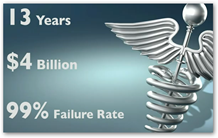This talks about how new drugs are developed and how using stem cells can accelerate the processes. It’s very expensive to create a new drug and takes an average of 13 years to bring the drug to market.  She uses Viox as an example of a drug that works for some and yet not for others. By using an array of stem cells they can now do genetic testing in a petri dish. Clinical trials can be done with stem cells. We are all different and by testing in a dish can help with trials to find the genetic codes of individuals to where the drug would help and others that would have adverse results. She addresses the gap between academia and the drug industry and how it needs to come together. IPS cells are used to create the “sick” cells for study and the model of the disease. The symptoms occur in the dish long before they would appear in a human. This will speed up the drug creation process and reduce the average down quite a bit from 13 years.
She uses Viox as an example of a drug that works for some and yet not for others. By using an array of stem cells they can now do genetic testing in a petri dish. Clinical trials can be done with stem cells. We are all different and by testing in a dish can help with trials to find the genetic codes of individuals to where the drug would help and others that would have adverse results. She addresses the gap between academia and the drug industry and how it needs to come together. IPS cells are used to create the “sick” cells for study and the model of the disease. The symptoms occur in the dish long before they would appear in a human. This will speed up the drug creation process and reduce the average down quite a bit from 13 years.
A stem cell robot has been created to help in this process. She states that they will in time want to test all the drugs on the market with the process and the robot. This work is done at the New York Stem Cell Laboratory. BD
Calling them "our bodies' own repair kits,"  Susan Solomon advocates research using lab-grown stem cells. By growing individual pluripotent stem cell lines, her team creates testbeds that could accelerate research into curing diseases -- and perhaps lead to individualized treatment, targeted not just to a particular disease but a particular person.
Susan Solomon advocates research using lab-grown stem cells. By growing individual pluripotent stem cell lines, her team creates testbeds that could accelerate research into curing diseases -- and perhaps lead to individualized treatment, targeted not just to a particular disease but a particular person.
http://www.youtube.com/watch?v=CY_Oj59WlL0&feature=em-subs_digest
Home
»
Medically Related
»
Other Items of Interest
»
Technology
»
Promise of Research With Stem Cells With Creating Better Drugs and Trials in the Petri Dish - Cutting Down the Development & Cost Time TED Video
Subscribe to:
Post Comments
(
Atom
)



0 comments :
Post a Comment